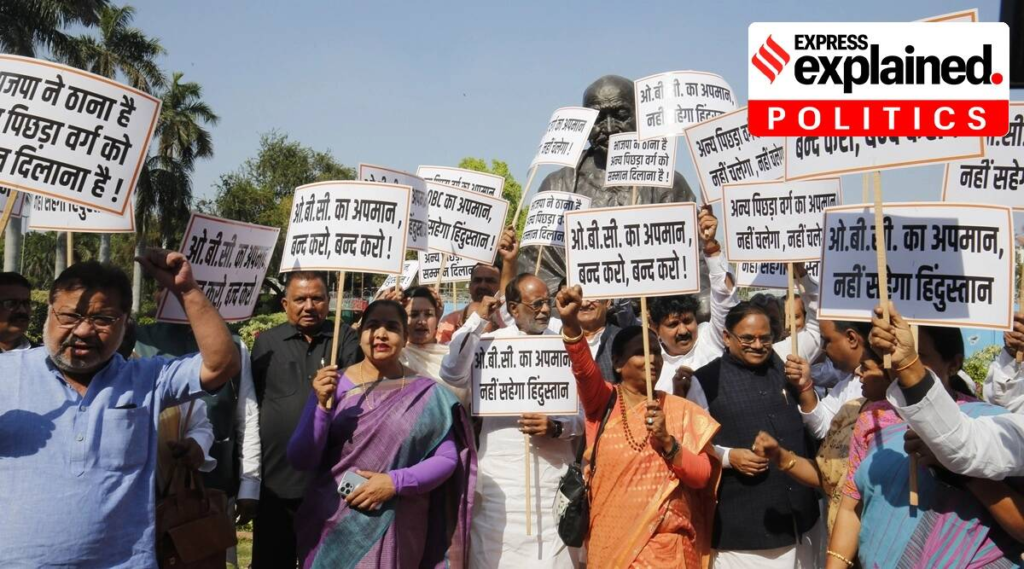The BJP has announced a nationwide campaign around Congress leader Rahul Gandhi’s alleged insult to Other Backward Classes (OBCs) in remarks for which he has been convicted of defamation and, in consequence, disqualified from Parliament.
While the Congress rejects the BJP’s allegation that it is biased against OBCs, the political history of India shows the party has missed several opportunities to reach out to these castes, including failing to claim credit for policy changes that were initiated by its governments.
Independence to Mandal
Political representation for the backward classes, as well as demands for reservation on the lines of quotas for Scheduled Castes and Scheduled Tribes, began soon after Independence.
In 1953, the government of Jawaharlal Nehru set up the first Backward Classes Commission (the expression ‘OBC’ was not in wide use at the time) under the chairmanship of Rajya Sabha member Kaka Kalelkar. The Commission submitted its report in 1955, but no action was taken on it.
Gradually, OBCs in the Hindi heartland moved towards the socialist leader Ram Manohar Lohia, and powered his politics in the early Sixties. After Lohia’s untimely demise in 1967 at age 57, Chaudhary Charan Singh, the Jat leader from Western UP, emerged as the leader of OBCs.
In October 1975, Hemwati Nandan Bahuguna, who was the Congress Chief Minister of Uttar Pradesh between November 1973 and November 1975, appointed the Most Backward Classes Commission under the chairmanship of Chhedi Lal Sathi — the first push for an OBC quota in Uttar Pradesh.
Subsequently, in April 1977, the government of another Congress titan, N D Tiwari, who succeeded Bahuguna after a phase of President’s Rule, announced a 15 per cent quota in government jobs for OBCs in UP, perhaps the first such move anywhere in the country.
Within a week, however, Tiwari’s government was dismissed by the Janata Party government led by Prime Minister Morarji Desai, which had come to power at the Centre following the post-Emergency elections of March 1977.
Consequently, it was UP’s Janata government led by Ram Naresh Yadav (1977-79) which implemented the quota — and also took the credit for it.
OBCs, Congress, BJP
In August 1990, the central government led by Congress rebel V P Singh announced its intention to implement the report of the Socially and Educationally Backward Classes Commission, popularly known as the Mandal Commission.
The Mandal Commission had been constituted by the Morarji government in 1978, and its report — recommending 27 per cent reservation for OBCs — had been submitted in 1980, but the governments of Indira and Rajiv Gandhi had chosen not to act on it.
The implementation of the report of the Mandal Commission unleashed a wave of OBC assertion and fundamentally altered the politics of North India. It catapulted leaders like Mulayam Singh Yadav, Lalu Prasad, Nitish Kumar, and Sharad Yadav to national prominence, and sealed the fate of the Congress in UP and Bihar.
In his 2006 biography of V P Singh, Manzil Se Zyada Safar, Ram Bahadur Rai quoted the former PM as having said: “Congress leaders were obsessed with power equations. They were least concerned with the social equations and changes taking place… It was unable to read the Mandal phenomenon. It took a lot of time to understand the importance of coalition power… The BJP has shown more flexibility than the Congress on (striking alliances).”
Indeed, the BJP — at that time still considered a largely Brahmin-Bania party — showed the political flexibility to project OBC leaders such as Kalyan Singh, a Lodh Rajput, in UP, to counter Mulayam. As Mulayam’s support base outside the Samajwadi Party’s Yadav-Muslim core started to fragment, Kalyan rallied smaller OBC communities behind the BJP, eventually forging a non-Yadav OBC vote bank. After OBC leaders like Kalyan and Uma Bharti became rebels within the party, the BJP revamped its leadership at every level to accommodate these communities politically.
Kalyan’s successor Ram Prakash Gupta (Nov 1999-Oct 2000) granted Jats OBC status in UP. In a bid to weaken both Mulayam and BSP chief Mayawati, the government of Chief Minister Rajnath Singh (Oct 2000-Mar 2002) devised a “reservation within reservation” to divide OBCs and Dalits.
UPA govt and later
In 2006, Arjun Singh, the Union Human Resource Development Minister in the UPA-1 government, fought back pressures to push through 27 per cent reservation for OBCs in admissions to central educational institutions, which had been pending since the implementation of the Mandal report. It was one of the biggest decisions in favour of OBCs, and a defining moment in OBC politics — but hardly any gains accrued to the Congress.
In 2010, the UPA-2 government initiated a move for a caste census. Then Law Minister Veerappa Moily wrote to Prime Minister Manmohan Singh about collecting caste/ community data in Census 2011. But on March 1, 2011, Home Minister P Chidambaram opposed the decision in Lok Sabha. Singh’s government ultimately decided to conduct a full Socio Economic Caste Census (SECC) instead.
The SECC data was published by the Ministries of Rural Development and Housing & Urban Poverty Alleviation, which conducted the census in rural and urban areas respectively, in 2016. However, the data remain unavailable. The Narendra Modi government has said it is “not reliable”.
There is no precise estimate of India’s OBC population. The National Commission for Backward Classes lists over 2,600 castes in the central list of OBCs for 27% reservation. The Mandal Commission said OBCs were 52% of the population. A report based on the National Sample Survey Organisation’s 61st round, released in October 2006, put this figure at 41%
Demolition along Yamuna floodplains: ‘They are removing poor people’


 Shyamlal Yadav… read more
Shyamlal Yadav… read more

